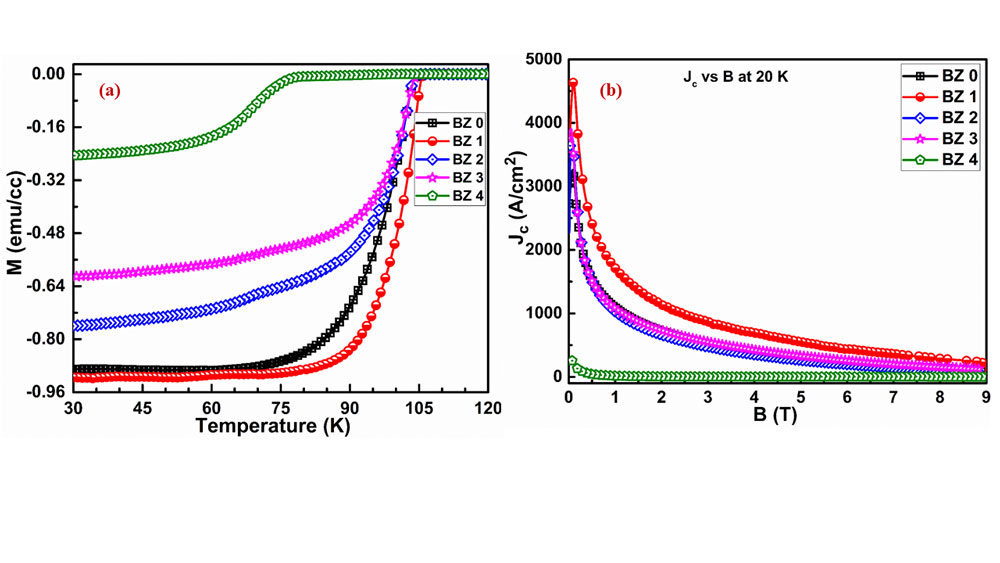WB6-5
Effect of nano ZrO2 doping on the superconducting properties of Ca0.86Sr0.14CuO2 added Bi 2223 composites
1Nov. 30 19:35-19:50
*Pawan Kumar Verma1, Shamili C Das2, Kuzhichalil Peethambharan Surendran2, Seshu Bai Vummethala1
School of Physics, University of Hyderabad, Hyderabad-500046 INDIA1
Material science and technology division, NIIST, Thiruvananthapuram, Kerala 695019 INDIA2
(Bi,Pb)-Sr-Ca-Cu-O system is one of the multicomponent systems having a very complex phase diagram [1]. Large anisotropy, high flux creep, and poor grain connectivity make it difficult, especially for practical applications close to 77 K [2]. The processing conditions for Bi 2223 superconductors are challenging to optimise, due to the narrow temperature window of phase formation.
Bi 2223 suffers high flux creep as compared to YBCO and hence to make it usable for real applications, one needs to tune it by adding sufficient pinning centers without affecting the superconducting matrix so that enhanced critical current density (Jc) can be achieved at high temperatures and fields. The addition of the secondary phase helps in generating pinning centers of the suitable size to arrest the flux lines such that high Jc is maintained without any dissipation. Some reports in the literature suggest that the secondary phase deteriorates the superconducting properties in lieu of improving [3-4]. But this depends on whether the second phase reacts with the matrix phase.
Bi1.2Pb0.3Sr1.54Ca2.06Cu3O10+δ is the superconducting compound obtained from a series series (Bi,Pb)2Sr2(Ca0.86Sr0.14)n-1CunOy [5], after normalizing to 3 Cu atoms. In the present work, we report a systematic work on Ca0.86Sr0.14CuO2 (20 mol%) added Bi 2223 composites with x wt.% nano ZrO2 addition. The concentration (x) of nano ZrO2 particles is varied as 0, 0.5, 1, and 10 wt.%. From Fig. (a) given below, one can see that the Meissner fraction decreases systematically with the increase of nano ZrO2 addition. All samples are superconducting as seen from the diamagnetic transitions. The Tc (Onset) for samples BZ 0- BZ 3 are around 105 K, while for the sample BW 4, it is around 80 K. The Jc vs B curves for all samples are shown in Fig. (b). J·c at 20 K is the highest for sample BZ 1 and lowest for sample BZ 4. Results are correlated to the data on phase formation obtained from XRD studies. Detailed analysis of pinning mechanisms will be presented in the light of theoretical models in the literature.
References:
1) P. Majewski, Phase diagram studies in the system Bi-Pb-Sr-Ca-Cu-O-Ag, Supercond. Sci. Technol. 10 (1997) 453–467
2) Alex Gurevich, Annu. Rev. Condens. Matter Phys. 2014. 5:35–56, DOI:10.1146/annurev-conmatphys-031113-133822
3) O. V. Karisova et al, Critical Reviews in Solid State and Materials Sciences, 39:253–276, 2014, DOI: 10.1080/10408436.2013.836073
4) Z.Y. Jia et al, Physica C 337 (2000) 130–132
5) V. Seshu Bai et al, Journal of Applied Physics 70, 4378-4382 (1991)
Acknowledgments:
Research funding from DST/SERB/ EMR/2016/006004 and facilities at School of Physics, UOH and at NIIST are acknowledged.
Figure Caption:
Figure:
(a) Temperature dependence of magnetization for all samples showing Tc (Onset),
(b) Field dependence of critical current density(Jc) at 20 K showing non zero Jc till 9 T applied field
Keywords: ZrO2 nano particles, Pinning centers, Flux Pinning, Grain connectivity
